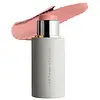What's inside
What's inside
 Key Ingredients
Key Ingredients

 Benefits
Benefits

 Concerns
Concerns

 Ingredients Side-by-side
Ingredients Side-by-side

Mica
Cosmetic ColorantCoco-Caprylate/Caprate
EmollientCetearyl Ethylhexanoate
EmollientGlycerin
HumectantSorbitan Oleate Decylglucoside Crosspolymer
CleansingCaprylyl Glycol
EmollientEthylhexylglycerin
Skin ConditioningSqualane
EmollientWater
Skin Conditioning1,2-Hexanediol
Skin ConditioningPentylene Glycol
Skin ConditioningSodium Chloride
MaskingPentaerythrityl Tetra-Di-T-Butyl Hydroxyhydrocinnamate
AntioxidantChondrus Crispus Extract
Skin ConditioningOctyldodecyl Stearoyl Stearate
EmollientXanthan Gum
EmulsifyingZinc Stearate
Cosmetic ColorantLauroyl Lysine
Skin ConditioningSimmondsia Chinensis Seed Oil
EmollientSodium Citrate
BufferingMauritia Flexuosa Fruit Oil
Skin ConditioningRosmarinus Officinalis Leaf Extract
AntimicrobialHelianthus Annuus Seed Oil
EmollientTocopherol
AntioxidantCI 77891
Cosmetic ColorantCI 77491
Cosmetic ColorantCI 77007
Cosmetic ColorantCI 77510
Cosmetic ColorantMica, Coco-Caprylate/Caprate, Cetearyl Ethylhexanoate, Glycerin, Sorbitan Oleate Decylglucoside Crosspolymer, Caprylyl Glycol, Ethylhexylglycerin, Squalane, Water, 1,2-Hexanediol, Pentylene Glycol, Sodium Chloride, Pentaerythrityl Tetra-Di-T-Butyl Hydroxyhydrocinnamate, Chondrus Crispus Extract, Octyldodecyl Stearoyl Stearate, Xanthan Gum, Zinc Stearate, Lauroyl Lysine, Simmondsia Chinensis Seed Oil, Sodium Citrate, Mauritia Flexuosa Fruit Oil, Rosmarinus Officinalis Leaf Extract, Helianthus Annuus Seed Oil, Tocopherol, CI 77891, CI 77491, CI 77007, CI 77510
Caprylic/Capric Triglyceride
MaskingKaolin
AbrasiveCaprylyl Caprylate/Caprate
EmollientSimmondsia Chinensis Seed Oil
EmollientPolyethylene
AbrasiveMica
Cosmetic ColorantPolyhydroxystearic Acid
EmulsifyingLecithin
EmollientBehenylcarbamoylpropyl Polysilsesquioxane
Tocopherol
AntioxidantAscorbyl Palmitate
AntioxidantCitric Acid
BufferingRubus Idaeus Leaf Cell Culture
Skin ConditioningCI 75470
Cosmetic ColorantTitanium Dioxide
Cosmetic ColorantCI 77891
Cosmetic ColorantIron Oxides
CI 77491
Cosmetic ColorantCI 77492
Cosmetic ColorantCI 77499
Cosmetic ColorantCI 73360
Cosmetic ColorantBlue 1 Lake
Cosmetic ColorantCI 42090
Cosmetic ColorantCI 15850
Cosmetic ColorantCI 19140
Cosmetic ColorantCaprylic/Capric Triglyceride, Kaolin, Caprylyl Caprylate/Caprate, Simmondsia Chinensis Seed Oil, Polyethylene, Mica, Polyhydroxystearic Acid, Lecithin, Behenylcarbamoylpropyl Polysilsesquioxane, Tocopherol, Ascorbyl Palmitate, Citric Acid, Rubus Idaeus Leaf Cell Culture, CI 75470, Titanium Dioxide, CI 77891, Iron Oxides, CI 77491, CI 77492, CI 77499, CI 73360, Blue 1 Lake, CI 42090, CI 15850, CI 19140
 Reviews
Reviews

Ingredients Explained
These ingredients are found in both products.
Ingredients higher up in an ingredient list are typically present in a larger amount.
Ci 77491 is also hydrated iron III oxide. It's sole purpose is to give a red/pink hue to products.
Iron III oxides are classified as inorganic chemicals for coloring.
Synthetically created Ci 77491 is considered safer than those naturally found. This is because the synthetically created version may contain less impurities. Iron oxides are generally non-toxic and non-allergenic.
Learn more about CI 77491Ci 77891 is a white pigment from Titanium dioxide. It is naturally found in minerals such as rutile and ilmenite.
It's main function is to add a white color to cosmetics. It can also be mixed with other colors to create different shades.
Ci 77891 is commonly found in sunscreens due to its ability to block UV rays.
Learn more about CI 77891Mica is a naturally occurring mineral used to add shimmer and color in cosmetics. It can also help improve the texture of a product or give it an opaque, white/silver color.
Serecite is the name for very fine but ragged grains of mica.
This ingredient is often coated with metal oxides like titanium dioxide. Trace amounts of heavy metals may be found in mica, but these metals are not harmful in our personal products.
Mica has been used since prehistoric times throughout the world. Ancient Egyptian, Indian, Greek, Roman, Aztec, and Chinese civilizations have used mica.
Learn more about MicaThis oil comes from the seeds of the desert shrub called Jojoba. It is more commonly known as jojoba oil, a non-comedogenic oil.
Jojoba oil does not contain fragrance and has many fatty-acids, making it a great soothing ingredient.
It also contains Vitamin E, a great moisturizing ingredient. Vitamin E is also an antioxidant and protects your skin against oxidative damage.
This ingredient humectant properties, meaning it helps draw moisture from the air. This helps keep your skin hydrated.
While jojoba has antibacterial properties, it is only able to kill some strains of bacteria.
Studies also show it helps in wound healing. In fact, Indigenous cultures have used jojoba as a moisturizer and to help treat burns for centuries.
Fun fact: Jojoba oil similar to natural human skin sebum, so it has a great effect on dry skin. It is also promising with helping to regulate sebum production.
Due to its fatty acid content, Jojoba oil may not be fungal acne safe. We recommend speaking with a professional if you have any concerns.
Learn more about Simmondsia Chinensis Seed OilTocopherol (also known as Vitamin E) is a common antioxidant used to help protect the skin from free-radicals and strengthen the skin barrier. It's also fat soluble - this means our skin is great at absorbing it.
Vitamin E also helps keep your natural skin lipids healthy. Your lipid skin barrier naturally consists of lipids, ceramides, and fatty acids. Vitamin E offers extra protection for your skin’s lipid barrier, keeping your skin healthy and nourished.
Another benefit is a bit of UV protection. Vitamin E helps reduce the damage caused by UVB rays. (It should not replace your sunscreen). Combining it with Vitamin C can decrease sunburned cells and hyperpigmentation after UV exposure.
You might have noticed Vitamin E + C often paired together. This is because it is great at stabilizing Vitamin C. Using the two together helps increase the effectiveness of both ingredients.
There are often claims that Vitamin E can reduce/prevent scarring, but these claims haven't been confirmed by scientific research.
Learn more about Tocopherol